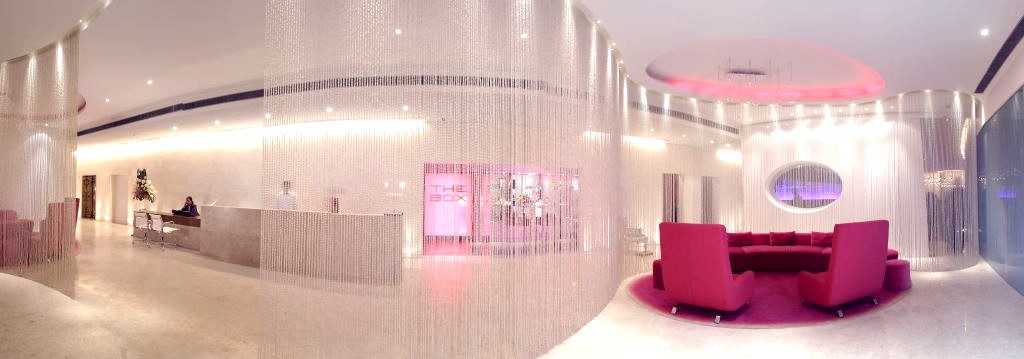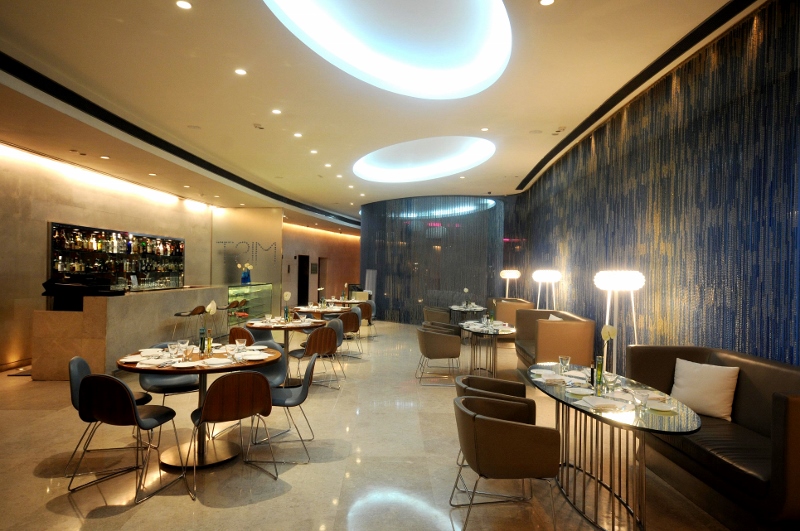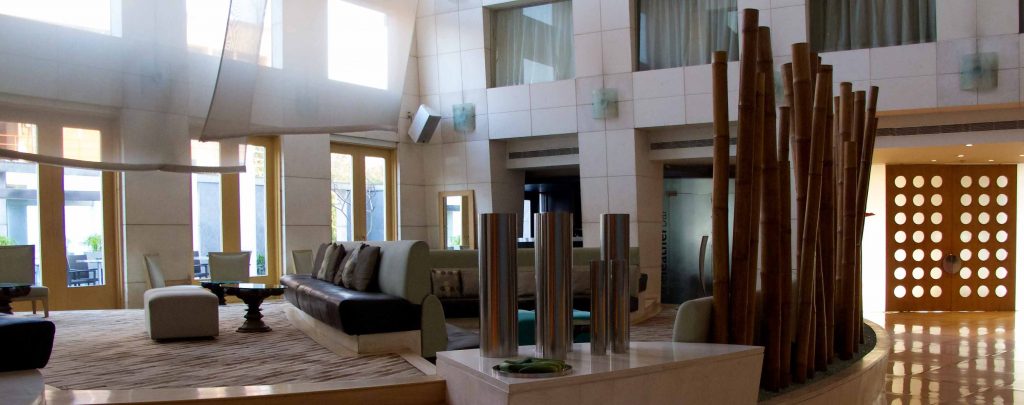Following THE Park Hotels celebrating 50 years of being unlike any other Indian hotel group, Priya Paul sat down with editor of Hotel Designs Hamish Kilburn to discuss the role of art in the hotel brand…
Just months ago, I was catching up with who I consider the businesswoman of the year (certainly in the hotel design sphere that is). Priya Paul is a delightful woman who exudes warmth and charm. Her kindness, however, should not be confused for weakness, as her team hit a major milestone, having just recently celebrated THE Park Hotels’ 50th anniversary. Paul defiantly pushed her brands to visually be worlds apart from any other luxury hotel in India. As well as providing personalised experiences for all guests checking in, each hotel in her portfolio is designed to be trendy, forward-thinking with art defining the hotel’s sense-of-place.
THE Park is present in Bangalore*, Chennai*, Hyderabad*, Kochi, Kolkata*, Navi Mumbai, New Delhi* and Visakhapatnam. THE Park Collection is intimate, personalised, and tailored to transmit an inimitable guest experience. It includes The Park Calangute* (Goa), The Park Baga River (Goa), The Denmark Tavern (Kolkata) and a heritage hotel in Chettinad (2019). Its sister brand, Zone By THE Park, is also across India, currently with seven hotels with the focus on tier two cities.
All of the hotels within the portfolio layer a strong emphasis of contemporary design in its private and public spaces. Style and luxury enhances everything – be it paintings, furniture, accessories or contemporary art.
The brand is heightened by each property’s boutique concept through an art route. The art objects spread all over these star deluxe hotels, gives them a specific identity.
Art in all its manifestations and forms are found in the various hotels. From traditional tribal art to edgy digital art and inspired installations enthrall our guests. Known artists share space with fresher inspiration. The result is a combination of dynamic interpretation of life.
Five minutes with Priya Paul:
Hamish Kilburn: How much of the overall budget would you allocate to art in one of your hotels?
Priya Paul: It depends from project to project . But it is about 5 per cent of the total budget of the project.
HK: How significant is good art in hotel design?
PP: It is extremely significant for me. I have always believed in using art and local handicrafts for each of my hotels. I am extremely lucky that I work in India, where each region has wonderful traditional crafts people. I enjoy working with them and enable traditional art and crafts into contemporary work for my hotels.
HK: You’re an experienced traveller. Without naming and shaming, what’s the worst art you have seen in hotels and how can hotels get it so wrong?
PP: For me personally the worst is when the hotel has put no thought into it and buys completely non-descript copies, while there are so many young artists that can be encouraged.
HK: How is art now being depicted beyond the frame in hotel design?
PP: Art is no longer something that hangs on the wall. We have used sculptures, ceramics and three-dimensional work in our hotels. We have used artworks as wallpapers and have even were the first ones to use video and digital art in hotels. Art is becoming more immersive. I know for my next project, I will work more with video and sound.
Examples of art and photography at THE Park Hotel:
THE Park, Chennai
The Park Chennai is an evocative luxury space located on the premises of erstwhile Gemini Film Studios. Elegant, Sensuous, Rich, it houses the theatre of life in its private and public spaces. The Hotel aims at creating a visual drama at every step. Well known artists have aptly brought out at The Park Hotels the chic and yet antique culture of Chennai.
The Lotus is the national flower of India and a sculpture by Hemi Bawa was chosen to be placed at the entrance of the hotel as a welcoming gesture. The Steel at the base depicts the water while the granite pebbles provide a shimmering effect. It exemplifies the fusion at various levels – of light and shadow, natural and manmade.
Manish Nai, an abstract artist has worked with mixed mediums like jute, paper etc. Born in 1980, he has completed his course from the L.S.Raheja School of Art, Mumbai. His works are also exhibited in Art Access Weel at Birla Academy, Nehru Centre and Cymroza Art Gallery. He exhibits his work at the lobby of THE Park Chennai.
Meanwhile, artist Sonja Weder’s work exhibits at 601 restaurant. She has used natural vegetation that is processed and laminated like her current exhibits the banana leaf and the flame of the forest.
Eminent sculptor Ray Mecker currently settled in Pondicherry uses ceramic as his medium for his abstract art which is displayed at the Atrium on the fourth floor.
THE Park Chennai proudly associates itself with talented art photographers who have lended their work at the public and private spaces of the hotel. To name a few they are Amit Pasricha, Sheena Sippy, Bharat Sikka, Bharat Ramaruthnam.
In the Pasha, there is a sculpture called HIGH at the entrance, a unique light sculpture by Krishnaraj Chonat is in the shape of a giant eagle suspended from the ceiling. Its bright red glow warms the white pearl encrusted silver leather wings.
Lobby comes alive every evening with the digitized projection of films on large screens. Digital art in the lift is by Sonia Khurana. Also in the lift are computer games and cartoons reflecting the changing times and tastes.

THE Park, Bangalore
The first contemporary Indian boutique hotel is small, luxurious and intimate. The first boutique hotel is all about style – a specially designed environment that creates a wealth of experience. Tatler Magazine in its definitive Travel Guide 2003 has rated this as one of the 101 best hotels in the world. It is a unique 109 -room experience, designed by Conran & Partners, UK.
The design philosophy is a fusion of the vibrant colours and landscapes of India with International style. Each area is specially designed to provide a richer and more sensual interaction. The hotel draws on Indian sensations and environment to provide travelers an ‘urban retreat’. The pristine white four-storied structure belies the luxury and flamboyance of the interiors. Flashes of brilliant colour from the balcony windows break the façade.
Some of the art that you will see here
Lobby: The main attraction in the lobby is an intricately carved black wooden pillar specially crafted by local craftsmen. The artistic pillar is a fusion of local hoysala art form and the much talked about Khajuraho art form. The pillar provides an exciting relief by its Indian feel amidst the contemporary feel of the lobby.
i-bar: The art installation at the I-bar is a backlit graphic, which is inspired by the focus on technology in the city also famous for silk. There are colourful strands, which depict silk threads and wires. Words like click, touch, feel that feature in the installation enhance the human angle to the piece. Paintings by Jiteh Kalet are strategically placed at the entrance to the bar.
Rooms and corridors: The photographers were specially commissioned for this area of the hotel. The first floor corridor showcases:
Coloured Photographs by Sanjay Acharya, Gurinder Osan, Manish Swaroop. The second and third floor has images by French photographer Laurent de Gaulle. Fourth floor sees the work of Nitin Upadhaya. Each room at The Park, Bangalore has black and white photographs showcasing the essence of the Garden City’s sights, sounds and scents. Saibal Das and Fawzan Hussain were specially commissioned to capture on film the city’s various moods across 24-hours – from daybreak at Cubbon Park to the bright night lights of MG road. These are an extension of The Park Hotels’ ideology – to incorporate the essence of the city in which it is located, into the design of its hotels.
THE Park, New Delhi:

MIST at THE Park New Delhi
Flagging off the heart of the Capital’s business and entertainment center, stands The Park New Delhi. It overlooks the historic 18th century Jantar Mantar Observatory and is in the city’s hub – Connaught Place.
The artists that you are likely to see here are AK Raina, Shobha Broota, Jagdish Dey, Altaf Hussain, Yusuf Arrakal, Ojha, Priya Ravish Mehra, Manish Kansara, Sukhvinder Singh, Morden Madhvani, Paramjit Singh, Pooja Broota, Hema Joshi.
THE Park, Vizag:
The Park, Vizag, spread over 7 acres of spectacular landscaped lawns, overlooking the Bay of Bengal, has a perfect, picturesque ambience as an urban beach resort. The Park’s location offers sandy beaches complete with a lighthouse to underline the romance of the sea with breathtaking sunrises and lovely tropical gardens. The art and décor of the hotel has traces of tribal art of Andhra Pradesh and the tropical themed landscaped lawns are co-related with the influence of Buddhist ruins found in and around the area.
Sculptures of Apsaras in stone greet you as you enter the hotel. The lobby also boats of Tribal Art from the neighboring Arakku Valley (Sculpture of Dristi Dolls) and traditional kalamkari paintings. Paintings by Kiran Rathore and Manish Gupta adorn the walls of the lift lobbies. The outdoor crafts court depicting the story of Ramayana is the creation of local artist Sairam. These pillars are perfect examples of Savara Art.
(Savara is ancient tribal clan who belong to the hills of coastal Andhra Pradesh. Traditionally these tribes believe in their Gods and Ghosts of their dead ancestors live with them on the paintings and pictures drawn in their homes. They consider each home to be a temple and most sacrifices are done within their home. Paintings are done with clay and chalk mostly in dark wheat, yellow, white and black colours. The pictures depict daily happenings and lifestyles of their community. The pictures are simple & follow a geometrical pattern of straight lines, triangles, squares and simple life forms.)





